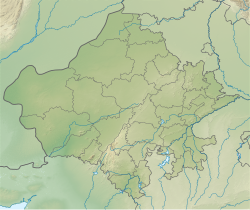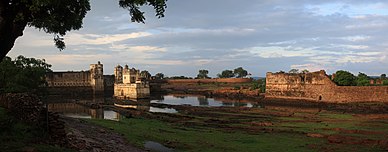Chittor Fort
| Chittor Fort | |
|---|---|
| Part ofChittorgarh | |
| Rajasthan,India | |
 A view of Chittorgarh Fort, Rajasthan, India | |
| Coordinates | 24°53′11″N74°38′49″E/ 24.8863°N 74.647°E |
| Site information | |
| Controlled by | S Parmar |
| Site history | |
| Battles/wars | Siege of Chittorgarh (1303) Battle of Chittor (1321) Siege of Chittorgarh (1535) Siege of Chittorgarh (1567–1568) |
| Garrison information | |
| Occupants | Mauryans of Chittorgarh,Guhilas of Medapata,Sisodias of Mewar |
| Type | Cultural |
| Criteria | ii, iii |
| Designated | 2014(36thsession) |
| Part of | Hill Forts of Rajasthan |
| Reference no. | 247 |
| Region | South Asia |
TheChittorgarh(literallyChittor Fort), also known asChittod Fort,is one of the largest living forts inIndia.It is aUNESCO World Heritage Site.The fort was the capital ofMewarand is located in the present-day city ofChittorgarh.It sprawls over a hill 180 m (590.6 ft) in height spread over an area of 280 ha (691.9 acres) above the plains of the valley drained by theBerachRiver. The fort covers 65 historic structures, which include four palaces, 19 large temples, 20 large water bodies, 4 memorials and a few victory towers.
In 2013, at the 37th session of theWorld Heritage Committeeheld inPhnom Penh,Cambodia,a group of fiveHill Forts of Rajasthan,including Chittor Fort, was declared aUNESCO World Heritage Site.[1]
Geography
[edit]
Chittorgarh,located in the southern part of the state of Rajasthan, 233 km (144.8 mi) fromAjmer,midway betweenDelhiandMumbaionNational Highway 8in the road network ofGolden Quadrilateral.Chittorgarh is situated where National Highways No. 76 and 79 intersect.
The fort rises abruptly above the surrounding plains and is spread over an area of 2.8 km2(1.1 sq mi). The fort stands on a hill 180 m (590.6 ft) high.[2]It is situated on the left bank of the Berach river (a tributary of theBanas River) and is linked to the new town of Chittorgarh (known as the 'Lower Town') developed in the plains after 1568 AD when the fort was deserted in light of introduction of artillery in the 16th century, and therefore the capital was shifted to the more secureUdaipur,located on the eastern flank of theAravalli hillrange. Mughal EmperorAkbarattacked and sacked this fort which was but one of the 84 forts of Mewar, but the capital was shifted to Aravalli hills where heavy artillery & cavalry were not effective. A winding hill road of more than 1 km (0.6 mi) length from the new town leads to the west end main gate, called Ram Pol, of the fort. Within the fort, a circular road provides access to all the gates and monuments located within the fort walls.[3][4][5][6]
The fort that once boasted of 84 water bodies has only 22 of them now. These water bodies are fed by natural catchment and rainfall, and have a combined storage of 4 billion litres that could meet the water needs of an army of 50,000. The supply could last for four years. These water bodies are in the form of ponds, wells and step wells.[7]
History
[edit]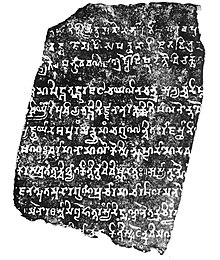
Chittorgarh (garhmeans fort) was originally called Chitrakut.[10]It is said to have been built by western branch of Mauryan rulerChitrangada Mori.[11]According to one legend, the name of the fort is derived from its builder.[10]Several small Buddhist stupas dated to 9th century based on the script were found at the edge of Jaimal Patta lake.[12][13]

TheGuhilarulerBappa Rawalis said to have captured the fort in either 728 CE or 734 CE. One account states that he received the fort indowry.[10]According to other versions of the legend, Bappa Rawal captured the fort either from theMoris.[14]HistorianR. C. Majumdartheorizes that the Moris were ruling at Chittor when the Arabs (mlechchhas) invaded north-western India around 725 CE.[14]The Arabs defeated the Moris, and in turn, were defeated by a confederacy that included Bappa Rawal. R. V. Somani theorized that Bappa Rawal was a part of the army ofNagabhata I.[15]Some historians doubt the historicity of this legend, arguing that the Guhilas did not control Chittor before the reign of the later ruler Allata.[16]The earliest Guhila inscription discovered at Chittor is from the reign ofTejasimha(mid-13th century); it mentions "Chitrakuta-maha-durga"(the great fort of Chittor).[17]
Chittor was known as "Chit-Ror"at that time. Between 1251 and 1258,Balbanrepeatedly led troops to Chitror fort.[18][19]Under the orders ofAlauddin Khilji,Ulugh Khanlaid a siege in the direction ofRanthambore,Chitror andBundiforts.[20][21]
Siege of 1303
[edit]In 1303, theDelhi Sultanateor Delhi Sultans rulerAlauddin Khaljiled an army to conquer Chittorgarh, which was ruled by theGuhilakingRatnasimha.[22]Alauddin captured Chittor after an eight-month-long siege.[23]According to his courtierAmir Khusrow,he ordered a massacre of 30,000 local Hindus after this conquest.[24]Some later legends state that Alauddin invaded Chittor to capture Ratnasimha's beautiful queenPadmini,but most modern historians have rejected the authenticity of these legends.[25]The legends also state that Padmini and other women committed suicide byjauhar(mass self-immolation). HistorianKishori Saran Lalbelieves that ajauhardid happen at Chittorgarh following Alauddin's conquest, although he dismisses the legend of Padmini as unhistorical.[26]On the other hand, historianBanarsi Prasad Saksenaconsiders thisjauharnarrative as a fabrication by the later writers, because Khusrow does not mention anyjauharat Chittorgarh, although he has referred to thejauharduring theearlier conquest of Ranthambore.[27]
Alauddin assigned Chittorgarh to his young son Khizr Khan (or Khidr Khan), and the Chittor fort was renamed "Khizrabad" after the prince. As Khizr Khan was only a child, the actual administration was handed over to a slave named Malik Shahin.[27]
Rana Hammir and successors
[edit]Khizr Khan's rule at the fort lasted till 1311 AD and due to the pressure ofRajputshe was forced to entrust power to the Sonigra chief Maldeva who held the fort for 7 years.Hammir Singh,usurped control of the fort from Maldeva and Chittor once again regained its past glory. Hammir, before his death in 1378 AD, had convertedMewarinto a fairly large and prosperous kingdom. The dynasty (and clan) fathered by him came to be known by the nameSisodiaafter the village where he was born. His sonRana Kshetra Singhor Rana Kheta succeeded him and ruled with honour & power. Rana Kheta's sonRana Lakha(Lakshya), who ascended the throne in 1382 AD, also won several wars. His famous grandsonRana Kumbhacame to the throne in 1433 AD and by that time theMuslimrulers of Malwa and Gujarat had acquired considerable clout and were keen to usurp the powerful Mewar state.[28]
Rana Kumbha and clan
[edit]
There was resurgence during the reign of Rana Kumbha in the 15th century. Rana Kumbha, also known as Maharana Kumbhakarna, son ofRana Mokal,ruled Mewar between 1433 AD and 1468 AD. He is credited with building up the Mewar kingdom assiduously as a force to reckon with. He built 32 forts (84 fortresses formed the defense of Mewar) including one in his own name, calledKumbalgarh.His younger son,Rana Raimal,assumed thereinsof power in 1473.[citation needed]After Raimal's death in May 1509, Sangram Singh (also known as Rana Sanga), his younger son, became the ruler of Mewar, which brought in a new phase in the history of Mewar.
Chittorgarh Under Rana Sanga
[edit]Rana Sangaascended the throne in 1509 after a long struggle with his brothers Prithviraj and Jaimal. He was an ambitious king under whom Mewar reached its zenith in power and prosperity.Rajputstrength under Rana Sanga reached its zenith and threatens to revive their powers again inNorthern India.[29]He established a strong kingdom fromSatlujinPunjabin North tillNarmada Riverin South inMalwa.After conqueringMalwaand theThar desertto the west and untilBayanain the east. In his military career he defeatedIbrahim Lodhiat theBattle of Khatoliand manage to free most ofRajasthanalong with that he mark his control over parts ofUttar Pradeshincluding Chandwar, he gave the part of U.P to his allies Rao Manik Chand Chauhan who later supported him inBattle of khanwa.[30]After that Rana Sanga fought another battle with Ibrahim Lodhi known asBattle of Dholpurwhere again Rajput confederacy were victorious. This time following his victory Sanga conquered much of theMalwaalong withChanderiand bestowed it to one of his vassalMedini Rai.Rai ruled overMalwawithChanderias his capital.[31]Sanga also invadedGujaratwith 50,000Rajput confederacyjoined by his three allies. He plunderedGujaratsultanate and chased the Muslim Army as far as capitalAhmedabad.He successfully annexed Northern Gujarat and appoint one of his vassals to rule there. Following the series of victories over Sultans he successfully establish his sovereignty overRajasthan,Malwaand large parts ofGujarat.[32]After these victories he united severalRajputstates fromNorthern Indiato expelBaburfromIndiaand re-establishHindupower in Delhi. [33]He advanced with a grand army of 100,000Rajputssupported by a few Afghans to expelBaburand to expand his territory by annexingDelhiandAgra.[34][35]The battle was fought for supremacy ofNorthern IndiabetweenRajputsandMughals.[36] HoweverRajput Confederationsuffered a disastrous defeat atKhanwadue to Babur's superior generalship and modern tactics. The battle was more historic thanFirst Battle of Panipatas it firmly establishMughalrule in India while crushing re-emergingRajputpowers. The battle was also earliest to usecannons,matchlocks,swivel guns andmortarsto great use.[37]
Rana Sanga was taken away from the battlefield in an unconscious state by his vassalsPrithviraj Singh IofJaipurandMaldeo RathoreofMarwar.After regaining consciousness he took an oath to never return to Chittorgarh until he defeated Babur and conquer Delhi. He also stop wearing turban and used to wrap a cloth over his head.[38]While he was preparing to wage another war againstBaburhe was poisoned by his own nobles who did not want another battle withBabur.He died inKalpiin January 1528.[39]
After his defeat his vassalMedini Raiwas defeated by Babur atBattle of Chanderiand Babur captured the capital of Rai kingdomChanderi.Medini was offered Shamsabad instead of Chanderi as it was historically important in conquering Malwa but Rai refused the offer and chose to die fighting. TheRajputwomen and children committedself-immolationto save their honour from Muslim army. After the victory, Babur captured Chanderi along with Malwa which was ruled by Rai.[40]
Post Rana Sanga
[edit]Siege of 1535
[edit]Bahadur Shahwho came to the throne in 1526 AD as the Sultan of Gujarat besieged the Chittorgarh fort in 1535. The fort was sacked and, once again the medieval dictates of chivalry determined the outcome. Following the escape of the Rana Vikramaditya, his brotherUdai Singh IIand the faithful maidPanna Daito their maternal relatives land ofBundi,it is said that their motherRani Karnavatiled 13,000 Rajput women in committingjauhar(self-immolation on the funeral pyre) as 3,200 Rajput warriors rushed out of the fort to fight till death (Saka) and died in the ensuing battle.[3][28]
Siege of 1567
[edit]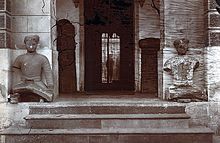
The finalSiege of Chittorgarhcame 33 years later, in 1567, when the Mughal EmperorAkbarattacked the fort. Akbar wanted to conquer Mewar, which was being ruled byRana Uday Singh IIto gain easy access to the Gujarati ports and establish a trade route.
Shakti Singh, son of the Rana who had quarreled with his father, had run away and approached Akbar when the later had camped atDholpurpreparing to attack Malwa. During one of these meetings, in August 1567, Shakti Singh deduced from a remark made in jest by emperor Akbar that he intended to wage war against Chittorgarh. Akbar had told Shakti Singh in jest that since his father had not submitted himself before him like other princes and chieftains of the region he would attack him. Startled by this revelation, Shakti Singh quietly rushed back to Chittorgarh and informed his father of the impending invasion by Akbar. Akbar was furious with the departure of Shakti Singh and decided to attack Mewar to humble the arrogance of the Ranas.[41]
In September 1567, the emperor left for Chittorgarh, and on 20 October 1567, camped in the vast plains outside the fort. In the meantime, Rana Udai Singh, on the advice of his council of advisors, decided to go away from Chittor to the hills ofGogundawith his family.JaimalandPattawere left behind to defend the fort along with 8,000 Rajput soldiers under their command. Akbar laid siege to the fortress, which lasted for 4 months.
On 22 February 1568, Jaimal was killed by a musket shot fired by Akbar himself.[citation needed]Jauhar was committed in the houses of Patta, Aissar Das, and Sahib Khan. The next day the gates of the fort were opened and Rajput soldiers rushed out to fight the enemies. In the ensuing battle, the army of Chittorgarh were killed alongside 20,000–25,000 civilians and Chittorgarh was conquered.
Mughal–Rajput peace treaty of 1615
[edit]In 1615, after a treaty betweenJahangirandAmar Singh,Chittorgarh was given back to Amar Singh by Jahangir.[42][page needed]
The fort was refurbished in 1905 duringBritish Raj.[43]
Precincts
[edit]
The fort, which is roughly in the shape of a fish, has a circumference of 13 km (8.1 mi) with a maximum length of 5 km (3.1 mi) and it covers an area of 700 acres.[44]The fort is approached through a difficult zig-zag ascent of more than 1 km (0.6 mi) from the plains, after crossing over alimestonebridge. The bridge spans the Gambhiri River and is supported by ten arches (one has a curved shape while the balance have pointed arches). Apart from the two tall towers, which dominate the majestic fortifications, the sprawling fort has a plethora of palaces and temples (many of them in ruins) within its precincts.[45][5]
The 305 hectare component site, with a buffer zone of 427 hectares, encompasses the fortified stronghold of Chittorgarh, a spacious fort located on an isolated rocky plateau of approximately 2 km length and 155 m width.
It is surrounded by a perimeter wall 13 km (8.1 mi) long, beyond which a 45° hill slope makes it almost inaccessible to enemies. The ascent to the fort passes through seven gateways built by the Mewar ruler Rana Kumbha (1433–1468) of theSisodiaclan. These gates are called, from the base to the hilltop, the Paidal Pol, Bhairon Pol, Hanuman Pol, Ganesh Pol, Jorla Pol, Laxman Pol, and Ram Pol, the final and main gate.
The fort complex comprises 65 historic built structures, among them 4 palace complexes, 19 main temples, 4 memorials, and 20 functional water bodies. These can be divided into two major construction phases. The first hill fort with one main entrance was established in the 5th century and successively fortified until the 12th century. Its remains are mostly visible on the western edges of the plateau. The second, more significant defence structure was constructed in the 15th century during the reign of the Sisodia Rajputs, when the royal entrance was relocated and fortified with seven gates, and the medieval fortification wall was built on an earlier wall construction from the 13th century.
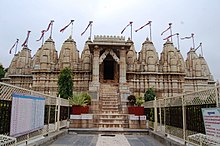
Besides the palace complex, located on the highest and most secure terrain in the west of the fort, many of the other significant structures, such as the Kumbha Shyam Temple, theMira BaiTemple, the Adi Varah Temple, the Shringar Chauri Temple, and the Vijay Stambh memorial were constructed in this second phase. Compared to the later additions of Sisodian rulers during the 19th and 20th centuries, the predominant construction phase illustrates a comparatively pureRajputstyle combined with minimal eclecticism, such as the vaulted substructures which were borrowed from Sultanate architecture. The 4.5 km walls with integrated circular enforcements are constructed from dressed stone masonry in lime mortar and rise 500 m above the plain. With the help of the seven massive stone gates, partly flanked by hexagonal or octagonal towers, the access to the fort is restricted to a narrow pathway which climbs up the steep hill through successive, ever narrower defence passages. The seventh and final gate leads directly into the palace area, which integrates a variety of residential and official structures. Rana Kumbha Mahal, the palace of Rana Kumbha, is a large Rajput domestic structure and now incorporates the Kanwar Pade Ka Mahal (the palace of the heir) and the later palace of the poetMira Bai(1498–1546). The palace area was further expanded in later centuries, when additional structures, such as the Ratan Singh Palace (1528–1531) or the Fateh Prakash, also named Badal Mahal (1885–1930), were added.

Although the majority of temple structures represent the Hindu faith, most prominently the Kalikamata Temple (8th century), the Kshemankari Temple (825–850) the Kumbha Shyam Temple (1448) or the Adbuthnath Temple (15th–16th century), the hill fort also containsJaintemples, such as Sattaees Devari, Shringar Chauri (1448) and Sat Bis Devri (mid-15th century) Also the two tower memorials,Kirti Stambh(12th century) andVijay Stambha(1433–1468), are Jain monuments. They stand out with their respective heights of 24 m and 37 m, which ensure their visibility from most locations of the fort complex. Finally, the fort compound is home to a contemporary municipal ward of approximately 3,000 inhabitants, which is located near Ratan Singh Tank at the northern end of the property.
Gates
[edit]
The fort has total seven gates (in local language, gate is calledPol) in the west, namely the Padan Pol, Bhairon Pol, Hanuman Pol, Ganesh Pol, Jodla Pol, Laxman Pol, and the main gate named the Ram Pol (Lord Rama's Gate). All the gateways to the fort have been built as massive stone structures with secure fortifications for military defense. The doors of the gates with pointed arches are reinforced to fend off elephants and cannon shots. The top of the gates has notched parapets for archers to shoot at the enemy army. A circular road within the fort links all the gates and provides access to the numerous monuments (ruined palaces and 130 temples) in the fort.
On the right of Suraj Pol is the Darikhana or Sabha (council chamber) behind which lie aGaneshatemple and thezenana(living quarters for women). A massive water reservoir is located towards the left of Suraj Pol. There is also a peculiar gate, called the Jorla Pol (Joined Gate), which consists of two gates joined. The upper arch of Jorla Pol is connected to the base of Lakshman Pol, a feature has not been noticed anywhere else in India.[4]The Lokota Bari is the gate at the fort's northern tip, while a small opening that was used to hurl criminals into the abyss is seen at the southern end.[3][4][5][46]
Vijaya Stambha
[edit]
The Vijaya Stambha (Tower of Victory) or Jaya Stambha, called the symbol of Chittorgarh and a particularly bold expression of triumph, was erected by Rana Kumbha between 1458 and 1468 to commemorate his victory over Mahmud Shah I Khalji, the Sultan of Malwa, in 1440 AD.[citation needed]Built over a period of ten years, it rises 37.2 metres (122 ft) over a 47 square feet (4.4 m2) base in nine stories accessed through a narrow circular staircase of 157 steps (the interior is also carved) up to the 8th floor, from where there is good view of the plains and the new town of Chittorgarh.[citation needed]The dome, which was a later addition, was damaged by lightning and repaired during the 19th century. The Stambha is now illuminated during the evenings and gives a beautiful view of Chittorgarh from the top.[3][45][5][47]
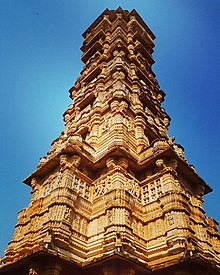
Kirti Stambha
[edit]
Kirti Stambha (Tower of Fame) is a 22-metre-high (72 ft) tower built on a 30-foot (9.1 m) base with 15 feet (4.6 m) at the top; it is adorned withJainsculptures on the outside and is older (probably 12th century) and smaller than the Victory Tower.[citation needed]Built by theBagherwalJain merchant Jijaji Rathod, it is dedicated toAdinath,the first Jaintirthankar(revered Jain teacher). In the lowest floor of the tower, figures of the various tirthankars of theJainpantheon are seen in special niches formed to house them. These are digambara monuments. A narrow stairway with 54 steps leads through the six storeys to the top. The top pavilion that was added in the 15th century has 12 columns.[3][4][45][5][48][49]
Rana Kumbha Palace
[edit]Rana Kumbha's palace (in ruins) is at the entrance gate near the Vijaya Stamba. The palace included elephant and horse stables and a temple to LordShiva.Maharana Udai Singh,the founder of Udaipur, was born here; the popular folk lore linked to his birth is that his maidPanna Daisaved him by substituting her son in his place as a decoy, which resulted in her son getting killed by Banbir.[citation needed]The prince was spirited away in a fruit basket. The palace is built with plastered stone. The remarkable feature of the palace is its splendid series of canopied balconies. Entry to the palace is through Suraj Pol which leads into a courtyard. The famous poet-saint, RaniMeera,also lived in this palace. This is also the palace where Rani Padmini is said to have consigned herself to the funeral pyre in one of the underground cellars, as an act ofJauharalong with many other women. The Nau Lakha Bandar (literal meaning: nine lakh treasury) building, the royal treasury of Chittorgarh was also located close by. Now, across from the palace is a museum and archaeological office. The Singa Chowri temple is also nearby.[3][4][5]
Fateh Prakash Palace
[edit]Located near Rana Khumba palace, built byRana Fateh Singh,the precincts have modern houses and a small museum. A school for local children (about 5,000 villagers live within the fort) is also nearby.[3][5]
Gaumukh Reservoir
[edit]
A spring feeds the tank from a carved cow's mouth in the cliff. This pool was the main source of water at the fort during the numerous sieges.[5]
Padmini's Palace
[edit]Padmini's Palace or Rani Padmini's Palace is a white building and a three storied structure (a 19th-century reconstruction of the original). It is located in the southern part of the fort.Chhatris(pavilions) crown the palace roofs and a water moat surround the palace. This style of the palace became the forerunner of other palaces built in the state with the concept of Jal Mahal (palace surrounded by water). Maharana Ratan Singh was killed and Rani Padmini committed Jauhar. Rani Padmini's beauty has been compared to that ofCleopatraand her life story is an eternal legend in the history of Chittorgarh. This Palace find its reference in some of the historical texts of Mewar. Amar Kavyam mentions the confinement of Mahmud Khilji- II, Sultan of Malwa here byRana Sanga.[50]MaharanaUdai Singhmarried his daughter JasmaDe to Rai Singh of Bikaner. A song was composed about the charity done by Rai Singh, in which it is mentions that he donated an elephant for each step of the stairs of Padmini's Palace. It was repaired by MaharanaSajjan Singh.
Other sights
[edit]
Close to Vijay Sthamba is the Meera Temple, or the Meerabai Temple. Rana Khumba built it in an ornate Indo-Aryan architectural style. It is associated with the mystic saint-poetMirabaiwho was an ardent devotee ofLord Krishnaand dedicated her entire life to His worship. She composed and sang lyricalbhajanscalled Meera Bhajans. The popular legend associated with her is that with blessings of Krishna, she survived after consuming poison sent to her by her evil brother-in-law. The larger temple in the same compound is the Kumbha Shyam Temple (Varaha Temple).[3][4][5]The pinnacle of the temple is in pyramid shape. A picture of Meerabai praying before Krishna has now been installed in the temple.[51]
Across from Padmini's Palace is theKalika Mata Temple.Originally, a Sun Temple dated to the 8th century dedicated toSurya(the Sun God) was destroyed in the 14th century. It was rebuilt as aKalitemple.[3][4][5]
Another temple on the west side of the fort is the oldGoddess Tulja BhavaniTemple built byBanvirand dedicated to Goddess Tulja Bhavani. TheTope Khana(cannon foundry) is located next to this temple in a courtyard, where a few old cannons are still seen.[5][52]
Culture
[edit]The fort and the city ofChittorgarhhost the biggest Rajput festival called the "Jauhar Mela".[2]It takes place annually on the anniversary of one of thejauhars,but no specific name has been given to it. It is generally believed that it commemorates Padmavati'sjauhar,which is most famous. This festival is held primarily to commemorate the bravery of Rajput ancestors and all threejauharswhich happened at Chittorgarh Fort. A huge number of Rajputs, which include the descendants of most of the princely families, hold a procession to celebrate the Jauhar. It has also become a forum to air one's views on the current political situation in the country.[53]
Six forts of Rajasthan, namely,Amber Fort,Chittorgarh Fort,Gagron Fort,Jaisalmer Fort,KumbhalgarhandRanthambore Fortwere included in theUNESCO World Heritage Sitelist during the 37th meeting of the World Heritage Committee in Phnom Penh in June 2013. They were recognized as a serial cultural property and examples of Rajput military hill architecture.[54][55]
The ruined city of the Cold Lairs fromThe Jungle BookbyRudyard Kipling,where the protagonistMowgliis taken to after being kidnapped by theBandar-log,is noted by the Kipling Society to have possibly been based on Chittorgarh Fort, which Kipling personally visited in 1887, and would have been relatively close to theAravalli Rangealso located inRajasthan,the original setting of the Jungle Books before Kipling changed it to the hills ofSeoniinMadhya Pradesh.[56][57]
Gallery
[edit]-
Columns in the fortress.
-
A part of the fortress.
-
Fort remains 1
-
Fort remains 2
-
Padmini Palace
-
Interiors of the Padmini Palace.
-
Structures in the fort 1
-
Structures in the fort 2
-
MeeraTemple
-
Jain templeat Kirtistambha
References
[edit]- ^Centre, UNESCO World Heritage."Hill Forts of Rajasthan".UNESCO World Heritage Centre.Retrieved1 July2024.
- ^ab"The Fantastic 5 Forts: Rajasthan Is Home to Some Beautiful Forts, Here Are Some Must-See Heritage Structures".DNA: Daily News & Analysis. 28 January 2014. Archived fromthe originalon 24 September 2015.Retrieved5 July2015.
- ^abcdefghiJoe Bindloss; James Bainbridge; Lindsay Brown; Mark Elliott; Stuart Butler (2007).India.Lonely Planet. pp. 124–126.ISBN978-1-74104-308-2.Retrieved24 June2009.
{{cite book}}:|work=ignored (help) - ^abcdefg"Indian States and Union Territories".Places of Interest in Rajasthan: Chtiiorgarh.Retrieved24 June2009.
- ^abcdefghijk"Chittorgarh Fort of Rajasthan in India".Archived fromthe originalon 4 June 2009.Retrieved22 June2009.
- ^"Places and Monuments".Archived fromthe originalon 17 July 2009.Retrieved24 June2009.
- ^"Rajasthan's Water fort".Rainwaterharvesting.Org.Retrieved24 June2009.
- ^Balogh, Dániel (9 December 2018)."Chittorgarh fragmentary inscriptions of the Naigamas, inked rubbing".doi:10.5281/zenodo.2105017.
- ^Epigraphia Indica Vol 34.pp. 53–58.
- ^abcPaul E. Schellinger & Robert M. Salkin 1994,p. 191.
- ^Shiv Kumar Tiwari 2002,p. 271.
- ^Chittorgarh, Shobhalal Shastri, 1928, pp. 64-65
- ^"Hill Forts of Rajasthan".
- ^abR. C. Majumdar 1977,p. 298-299.
- ^Ram Vallabh Somani 1976,p. 45.
- ^Ram Vallabh Somani 1976,p. 44.
- ^D. C. Ganguly 1957,p. 90.
- ^Al-Hind the Making of the Indo-Islamic World, p. 230
- ^Al-Hind The Making of the Indo-Islamic World · Volume 1, p. 230
- ^The History of India, as Told by Its Own Historians, p. 370
- ^Tabakat-i-Nasiri, p. 124
- ^Banarsi Prasad Saksena 1992,p. 366.
- ^Banarsi Prasad Saksena 1992,p. 367.
- ^Kishori Saran Lal 1950,pp. 119–120.
- ^Satish Chandra 2004,p. 89.
- ^Kishori Saran Lal 1950,p. 130.
- ^abBanarsi Prasad Saksena 1992,p. 368.
- ^abIshwari Prasad."A Short History of Muslim Rule in India".India in the sixteenth century.The Indian Press, Ltd. pp. paras 281 to 287.Retrieved22 June2009.
- ^History of Rajasthan by Deryck O.Lodrick
- ^Sharma 1954,p. 17.
- ^Chaurasia 2002,pp. 156–157.
- ^Sharma 1954,p. 18.
- ^Sharma 1954,p. 19.
- ^Sharma 1954,p. 34.
- ^Rao 1991,p. 452.
- ^Sharma 1954,p. 8.
- ^Rao 1991,p. 453-454.
- ^Sharma 1954,pp. 43.
- ^Sharma 1954,pp. 44.
- ^Chaurasia 2002,p. 157.
- ^"Akbarnama by Abu'l Fazl: H.M.'s Siege of the Fortress of Citur".Archivedfrom the original on 14 August 2017.Retrieved19 August2022.
- ^Chandra 2006.
- ^"Chittorgarh – The Largest Fort In India".The Mysterious India.18 December 2015.Retrieved18 November2021.
- ^"Chittorgharh Tourism: Places to Visit, Tourist Places & Chittor Fort - Rajasthan Tourism".www.tourism.rajasthan.gov.in.Retrieved13 September2021.
- ^abc"Chittorgarh Fort".Retrieved24 June2009.
- ^Pippa De Bruyn; Keith Bain; Niloufer Venkatraman; Shonar Joshi (2006).Frommer's India.Wiley Publishing, Inc. pp. 454=455.ISBN0-7645-6777-2.Retrieved26 June2009.
{{cite book}}:|work=ignored (help) - ^"Tower of Victory, Chittore Fort".Archived fromthe originalon 16 October 2012.Retrieved21 June2009.
- ^"The Khowasin Stambha, a Jaina tower at Cheetore".Archived fromthe originalon 16 October 2012.Retrieved23 June2009.
- ^"Chittaurgarh Fort, Chittaurgarh".Archived fromthe originalon 7 February 2009.Retrieved24 June2009.
- ^Ranchor Bhatt 1985,p. 186.
- ^Laxman Prasad Mathur (1990).Forts and strongholds of Rajasthan.New Delhi, India: Inter-India Publications. p. 24.ISBN81-210-0229-X.Retrieved26 June2009.
{{cite book}}:|work=ignored (help) - ^"Chittorgharh Tourism: Places to Visit, Tourist Places & Chittor Fort - Rajasthan Tourism".www.tourism.rajasthan.gov.in.Retrieved13 September2021.
- ^B.S. Nijjar (2007).Origins and History of Jats and Other Allied Nomadic Tribes of India.Atlantic Publishers & Distributors (P) Ltd. p. 306.ISBN978-81-269-0908-7.Retrieved26 June2009.
{{cite book}}:|work=ignored (help) - ^"Heritage Status for Forts".Eastern Eye. 28 June 2013. Archived fromthe originalon 24 September 2015.Retrieved5 July2015.
- ^"Iconic Hill Forts on UN Heritage List".New Delhi, India: Mail Today. 22 June 2013. Archived fromthe originalon 24 September 2015.Retrieved5 July2015.
- ^"Kaa's Hunting – Notes on the text".The Kipling Society.4 May 2021.Retrieved14 February2022.
- ^"Seeonee: The Site of Mowgli's Jungle?".The Kipling Society.17 June 2021.Retrieved14 February2022.
Bibliography
[edit]- Rao, K. V. Krishna(1991).Prepare Or Perish: A Study of National Security.Lancer Publishers.ISBN978-81-7212-001-6.
- Chaurasia, Radhey Shyam (2002).History of Medieval India: From 1000 A.D. to 1707 A.D.Atlantic Publishers & Dist.ISBN978-81-269-0123-4.
- Sharma, Gopi Nath (1954).Mewar & the Mughal Emperors (1526-1707 A.D.).S.L. Agarwala.
- Banarsi Prasad Saksena(1992). "The Khaljis: Alauddin Khalji". In Mohammad Habib and Khaliq Ahmad Nizami (ed.).A Comprehensive History of India: The Delhi Sultanat (A.D. 1206-1526).Vol. 5 (Second ed.). The Indian History Congress / People's Publishing House.OCLC31870180.
- D. C. Ganguly (1957). "Northern India During The Eleventh and Twelfth Centuries". InR. C. Majumdar(ed.).The Struggle for Empire.The History and Culture of the Indian People. Bharatiya Vidya Bhavan.OCLC26241249.
- G.H.R Tillotson (1987) [1987].The Rajput Palaces - The Development of an Architectural Style(Hardback) (First ed.). New Haven and London: Yale University Press. p. 224 pages.ISBN0-300-03738-4.
- George Michell; Antonio Martinelli (2005) [2005].The Palaces of Rajasthan.London: Frances Lincoln. p. 271 pages.ISBN978-0-7112-2505-3.
- Kishori Saran Lal(1950).History of the Khaljis (1290-1320).Allahabad: The Indian Press.OCLC685167335.
- Paul E. Schellinger; Robert M. Salkin, eds. (1994).International Dictionary of Historic Places: Asia and Oceania.Vol. 5. Routledge/Taylor & Francis.ISBN9781884964046.
- R. C. Majumdar (1977).Ancient India.Motilal Banarsidass.ISBN9788120804364.
- Ram Vallabh Somani (1976).History of Mewar, from Earliest Times to 1751 A.D.Mateshwari.OCLC2929852.
- Satish Chandra (2004).Medieval India: From Sultanat to the Mughals-Delhi Sultanat (1206-1526).Vol. 1. Har-Anand Publications.ISBN9788124110645.
- Chandra, Satish (2006).Medieval India: From Sultanat to the Mughals (1206–1526).Vol. 2. Har-Anand Publications.
- Shiv Kumar Tiwari (2002).Tribal Roots of Hinduism.Sarup & Sons.ISBN9788176252997.
- Viven Crump; Irene Toh (1996).Rajasthan(hardback). New York: Everyman Guides. p. 400.ISBN1-85715-887-3.
- Ranchor Bhatt (1985).Amar Kavyam(hardback). Udaipur: Sahitya Sansthan, Rajasthan Vidyapeeth.
External links
[edit] Media related toChittor Fortat Wikimedia Commons
Media related toChittor Fortat Wikimedia Commons Chittorgarhtravel guide from Wikivoyage
Chittorgarhtravel guide from Wikivoyage


